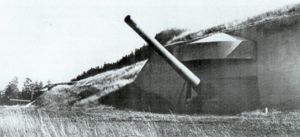Battery 131: Difference between revisions
John Stanton (talk | contribs) |
John Stanton (talk | contribs) |
||
| Line 6: | Line 6: | ||
{{Clr}} | {{Clr}} | ||
== {{PAGENAME}} History == | == {{PAGENAME}} History == | ||
Part of the [[:Category:Harbor Defense of Puget Sound|Harbor Defense of Puget Sound]] covering the entrance to Puget Sound, Victoria BC harbor, and the Canadian Esquimalt naval base. | |||
Battery 131 was a battery of two, 16", Mark II-M1, Long Range naval guns on M1919M4 Barbette carriages. Each gun position was in a reinforced concrete casemate. Construction began 30 Oct 1942 and was completed 10 May 1945. The Battery was turned over for service 7 Jun 1945 at a cost of $1,557,500. | Battery 131 was a battery of two, 16", Mark II-M1, Long Range naval guns on M1919M4 Barbette carriages. Each gun position was in a reinforced concrete casemate. Construction began 30 Oct 1942 and was completed 10 May 1945. The Battery was turned over for service 7 Jun 1945 at a cost of $1,557,500. | ||
Revision as of 12:07, 4 July 2009
Battery 131 (1945-194?) - A World War II era reinforced concrete Coastal Artillery Battery built in 1943-1945 on Camp Hayden, Washington. Guns were scrapped and removed about 1948 but the concrete Battery support structure remains.


Battery 131 History
Part of the Harbor Defense of Puget Sound covering the entrance to Puget Sound, Victoria BC harbor, and the Canadian Esquimalt naval base.
Battery 131 was a battery of two, 16", Mark II-M1, Long Range naval guns on M1919M4 Barbette carriages. Each gun position was in a reinforced concrete casemate. Construction began 30 Oct 1942 and was completed 10 May 1945. The Battery was turned over for service 7 Jun 1945 at a cost of $1,557,500.
The casemates were 500 feet apart at either end of an earth covered reinforced concrete support structure. The support structure housed a powder and shell room for each of the two gun emplacements along with storage rooms and latrines. Electrical power to operate the guns was furnished by three 375 KVA Worthington diesel engine powered generator sets positioned in the center of the battery. No commercial power was available. Each gun emplacement had four electric motors that 1) traversed the gun, 2) elevated the gun, 3) rammed the projectiles into the breech and 4) ventilated the emplacement. Heating, air conditioning and humidity control was provided to keep the shells and powder at a constant temperature and humidity.
The 16" guns could fire one-ton projectiles nearly 28 miles and covered most of the Straight of Juan De Fuca.
Electric torches and dynamite were used to break up the guns in 1948, creating 500 tons of scrap steel worth $30 a ton. The guns originally cost several million dollars apiece.
| Empl No |
Caliber Type |
Barrel Length |
Model | Serial No |
Manufacturer | Carriage | Service Dates |
Notes | |
|---|---|---|---|---|---|---|---|---|---|
| 1 | 16" Rifle | 68'3.75" | MarkII-M1 | 51 | Midvale | Barbette, M4, #37, Watertown | 1945-1948 | ||
| 2 | 16" Rifle | 68'3.75" | MarkII-M1 | 89 | Bethlehem | Barbette, M4, #38, Watertown | 1945-1948 | ||
| Source: Coast Defense Study Group | |||||||||

Current Status
Part of Salt Creek Recreation Area, Camp Hayden Callam County Park. No guns or carriages in place.
|
{"selectable":false,"width":"500"} |
Location: Tongue Point, Camp Hayden, Washington Maps & Images Lat: 48.1639 Long: -123.70206 |
Sources:
Links:
Visited:
Battery 131 Picture Gallery
|
Click on the picture to see a larger version. Contribute additional pictures - the more the better! |